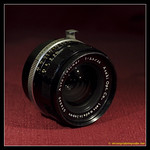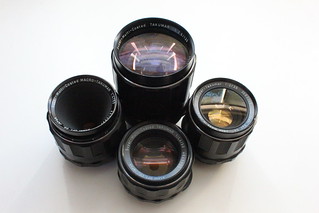Difference between revisions of "Takumar"
(→Super-Takumar Lenses) |
(→Super-Takumar Lenses) |
||
| Line 80: | Line 80: | ||
Many new lenses were developed in this era such as: 28mm, 24mm and finally a 20mm, the 35mm f/2.3 was replaced by the 35mm f/2.0 and later developed into a smaller version (49m filter) | Many new lenses were developed in this era such as: 28mm, 24mm and finally a 20mm, the 35mm f/2.3 was replaced by the 35mm f/2.0 and later developed into a smaller version (49m filter) | ||
At this point the best standard lens of the era was introduced the [[Takumar#50_14|50mm f/1.4]] first in 8-element configuration and later in a 7-element version. | At this point the best standard lens of the era was introduced the [[Takumar#50_14|50mm f/1.4]] first in 8-element configuration and later in a 7-element version. | ||
| + | <br> | ||
| + | <br> | ||
===Super Multi Coated (SMC) Lenses === | ===Super Multi Coated (SMC) Lenses === | ||
Revision as of 12:58, 26 June 2021
Takumar refers to a line of high quality photographic lenses produced by Asahi Optical Co beginning in the 1940s. The name was derived from Takuma Kajiwara (Kajiwara Takuma)[1], a well known Japanese-American photographer, whose nephew Kumao Kajiwara founded Asahi Kōgaku Kōgyō G.K. (Asahi Optical Corp). The name Takumar was used in lenses for SLRs until 1975, when K-mount replaced M42 and Pentax replaced Asahi, from then on lenses were badged mostly SMC Pentax, even though a few still had the name Takumar. Late in the 1980s Takumar was used for budget lenses for Pentax mount.
Asahi Optical is one of the oldest lens manufacturers, with complete capabilites of design, melting, and polishing several types of glass and mechanical engineers for the focusing mechanism, as such they made lenses for their own cameras, as well as some other companies. The first appearance of the Takumar name was in lenses used in the Asahiflex camera, which used the 37mm screw mount (1952). Takumar was carried over to the M42 cameras and went through a series of iterations as build quality and coatings were developed with names such as Super-Takumar, Super-Multi-Coated Takumar, and SMC Takumar. All lenses were provided in a leather case and a custom lens hood, except those that came as standard lenses with camera bodies. Filter sizes were also standardized by Asahi in order to help cutomers, being 49mm and 58mm for most lenses.[2]
These lenses are highly regarded among photographers, with some achieving cult-like status such as the Takumar 50mm f/1.4 and 35mm f/2.0. The build and image quality are superb and the easiness to adapt M42 mount to new camera mounts has transcended the use in new digital SLRs and mirrorless cameras.
Contents
Asahiflex Lenses
The Asahiflex was a unique camera with a 37x1 mm screw lens mount, and Asahi launched a whole line of lenses for it badged Asahi Kogaku Takumar. All these lenses were made in silver finished brass, with a few black trimmings in some late examples. Back caps were made in aluminum and front caps are aluminmum with black lacquer.

|
| Asahiflex Ia showing the mount 50/3.5 Takumar lens image by TOM (Image rights) |
These Takumars have some other interesting quirks. The aperture is pre-set and the iris is made up of 20 blades giving a nice round lens opening. [3]
No wide angle lenses were made, because of the presence of the mirror in the light path until retro-focus was discovered by Angenieux in the late 50s.
It's also of note that Asahi kept producing lenses for the Asahiflex after moving to M42 mount, retrofitting M42 lenses for the M37 mount as marked in the list.
- Standard lenses:
- Takumar 50mm f/3.5 (3 different versions)
- Takumar 58mm f/2.4
- Telephotos:
- Takumar 83mm f/1.9 (both in Asahiflex and M42 with adapter mount)
- Takumar 100mm f/3.5
- Tele-Takumar 135mm f/3.5
- Takumar 135mm f/3.5 (M42 with adapter)
- Takumar 500mm f/5.0
M42 Lenses

|
| TAKUMAR 135MM F3.5 image by Adrian Gee (Image rights) |
Asahi adopted the M42x1mm lens mount, which was originally developed by Contax, and used by Praktica, Pentacon and others, for their original Pentaprism SLR camera in 1957, Asahi Pentax (AP), and later the Asahi Pentax S and Asahi Pentax K (Tower 29) cameras. The badge Takumar was unchanged from the M37 lenses but are easily distinguishable by the change fom Asahi-Kogaku to Asahi-Optical and the scales in meter and feet depending on the target market. Takumar lenses were preset and initially came in a combination of black and chrome brass, with some very attractive lenses in "zebra" finish, these are listed as type 0 in the list of lenses. Several of these lenses were sold by Sears-Roebuck & Co in the USA as complement for their TOWER brand of cameras.
The limitation of wide-angle constructions were solved by this time, and Asahi developed a 35mm f/4.0 lens which was followed by the 35mm f/3.5 that was very popular and produced in M42 and K-mount up to 1979.
Auto Takumar

|
| AUTO-TAKUMAR 35MM F3.5 image by Adrian Gee (Image rights) |
These lenses were introduced in 1958 for use with the Pentax K camera, they have a semi-automatic aperture system, consisting of 2 rings and are listed as type I. One sets the aperture and the other is a spring loaded ring that keeps the aperture fully open for focusing. When pressing the shutter halfway, the camera pushes a pin on the rear of the lens closing the iris to the set aperture and have DOF check, then fully pressing the shutter takes the picture. The lens remains closed until the shutter is cocked for the next exposure.[4]
Several of these lenses were sold by Sears-Roebuck & Co in the USA as complement for their TOWER brand of cameras with a 55mm f/1.9 made especifically for them.
Super-Takumar Lenses

|
| SUPER-TAKUMAR LENSES 35/2, 50/1.4, 50/4-MACRO and 135/3.5 image by David Sides (Image rights) |
The Super-Takumars were introduced around 1962, improvements included single-layer lens coating and a fully-automatic diaphragm which not only closed the aperture to the preselected value, but after firing the shutter re-opened for focusing. A small lever to select "Auto/Manual" (A/M in early lenses) operation was added to use in cameras which don't support this feature. These lenses are generally single-coated however as Asahi developed coating technology some are multi-coated.
These series are marked Super-Takumar and are listed as type II. These lens were very popular, especially after the introduction of the Asahi Pentax Spotmatic and were sold by the millions. Due to the high quality of construction and optics of these lenses they are still being used by any aficionados in digital cameras, with a cult-like status in some of them.
Many new lenses were developed in this era such as: 28mm, 24mm and finally a 20mm, the 35mm f/2.3 was replaced by the 35mm f/2.0 and later developed into a smaller version (49m filter)
At this point the best standard lens of the era was introduced the 50mm f/1.4 first in 8-element configuration and later in a 7-element version.
Super Multi Coated (SMC) Lenses
listed as Type III
List of known M42 Lenses
- Type 0: Takumar preset: Succeeds the older 37mm version of the Takumar
- Type I: Auto-Takumar: An external lever is added to allow for full aperture focusing
- Type II: Super-Takumar: Fully-automatic diaphragm that does not needs to be cocked manually, single layer of coating, however some later versions are multi coated as Asahi's coating technology was improving
- Type III: Super-Multi-Coated Takumar: A 7 layer coating was applied for these lenses, the best available at the time, with improvements in contrast and color rendition. Extra pin for open aperture metering with the Spotmatic-F/ES/ES-II
- Type IV: SMC Takumar: last version of M42 lenses, uses a rubberized instead of the metal focusing ring to match the matching K-mount lenses
The lenses are listed, with the types known to exist for sure:
|
|
|
|
Legacy and notes
A note on Radioactive lenses
The Super Takumar 50/1.4
References
- Gerjan van Oosten, 2021, "The Definitive ASAHI PENTAX Collector's Guide 1952-1977". 2nd Edition